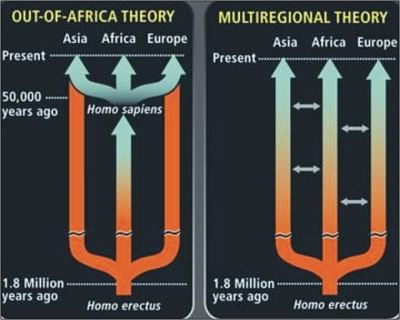Origin of modern humans

According to our knowledge of evolution, life has originated 3.5 billion years ago in a form of single cell wrapping essential molecules required to form life. After that, complexity came in life forms, multicellular organisms emerged, and evolution turned to macroevolution from microevolution. The first dinosaurs appeared 245 million years ago and dominated the earth till 65 million years ago. A comet or sudden meteoric shower on earth was, probably, responsible for their extinction. Ancient humans originated later after that. I am going to focus the origin of modern humans according to paleontology, the earth science that studies fossil organisms and related remains, and genetic evidence found to date. Since the separation of archaic humans, the hominids, from the apes around 5-7 million years ago the evolutionary tree generated branches for the newer ones. From the hominids, the genus homo had diverged around 2 million years ago in Africa.
It is hypothesized through paleoanthropological study and genetic evidence that around fifty or seventy years ago, a group of few hundred or even several thousand Africans left Africa forever. The reason they left their motherland might be climate change or scarcity of food supply from the ocean although the reasons are not clear. However, they started a journey, a journey to remember, a journey of human history taking with them the physical and behavioral traits, the intelligence including capacity for language which characterizes modern humans. Scientists are getting the insight of this historical journey by doing research on fossilized bones or spearheads. However, modern technology and the advent of molecular biology have offered more sophisticated ways to discover the insight of that journey. Although the paleoanthropologists are more focused on fossils rather than the DNA, the genetic information could be a better option to find out the markers present there to make the evolutionary tree.
There are, in fact, two theories regarding the origin of modern humans, one is out-of-Africa hypothesis that postulates that humans with modern traits left Africa from fifty to seventy thousand years ago to settle the world. In doing so, they replaced the archaic hominids, such as Homo erectus that left Africa as early as 1.8 million years ago. This out-of-Africa hypothesis gained support after the discovery of so called "Mitochondrial Eve" in 1987, when Rebecca L. Cann and Allan C. Wilson at the University of California, Berkeley, published a groundbreaking paper based on mitochondrial DNA analysis and concluded that humans from different population all descended from a single female in Africa who lived about 200,000 years ago. This out-of-Africa hypothesis is also called single origin theory or total replacement theory due to its nature of little or no interbreeding among the ancient human populations such as Homo Neanderthals and Homo erectus that left Africa. On the other hand, the multiregional theory or so called candelabra theory of regional continuity proposed by Milford H. Wolpoff in 1988 suggests that diversity from within Homo erectus and has confined over several million years, with some exchange of genes. It gives the idea that the modern characteristics of humans evolved not just in Africa but in archaic hominid population in Asia and Europe and interbreeding among all these groups ensured that they remained a single species. However, both the theory has proponents and opponents.
To get a clearer picture, therefore, more and more research both paleoantropological and genetic study is required. In fact, comparative genomics could be a very promising tool for the purpose because it may not be possible to get the identity of human population simply by analyzing a piece of DNA but comparative genomics may reveal the desired picture, may help to achieve the goal of the scientists working to unfold the mystery of the human evolution, the very origin of modern humans.

 For all latest news, follow The Daily Star's Google News channel.
For all latest news, follow The Daily Star's Google News channel. 



Comments